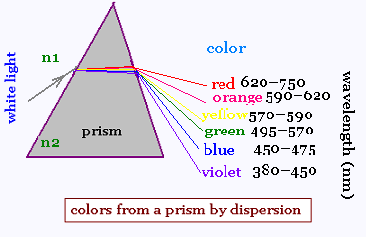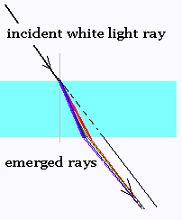Contents
ScientificSentence
© The scientific sentence. 2010
|
Optics: Index of refraction and Dispersion
The frequency ν of an electromagnetic radiation is given by its source.
Its wavelength λ is related to the medium where it propagates.
The speed of the radiation v is the product of ν and λ:
v = ν x λ.
1. Across the vacuum:
A ray of white light has a speed vo = c = 3.0 x 108 m/s
in the vacuum. This constant speed is the commun speed for all its color components
ranging from violet to red. This set of colors called optical spectrum. Each of its
component has its frenquency , then its wavelength, since λ0 = c/ν. In the vacuum,
their wavelengths have the following values in nm (nanometers):
| violet | 380�450 |
| blue | 450�475 |
| green | 495�570 |
| yellow | 570�590 |
| orange | 590�620 |
| red | 620�750 |
2. Across another medium:
The same white ray will have the speed vn in
another medium. The frequencies of its spectrum doe not change, because ν is fixed by the source,
its wavelengths do, so do their speeds vn = λ0 x μ. Threfore,
if a light ray has a speed "c" in the vacuum, its speed becomes vn in a certain medium.
The
ratio c/vn = n is called index of refraction of the medium witin the ray passes.
In other words, a medium changes the wavelength of a ray, then its speed. For example
the green ray has the wavelength range: 495-570 nm, and the speed "c" in the vacuum. In another
medium as the Crystal quartz, the wavelength range becomes 315-363 nm and the speed
becomes v = 2.0 x 108 m/s approximately. We have then,
for each optical
medium, a relationship betweenthe its index of refraction and the wavelength of the traveleing ray.
An index of refraction is not an intrinsic parameter of a medium. For a given optical medium "OP", its index
of refraction "n" is function of the wavelength of the traveling ray: nOP = f(λ). This
property is called dispersion.
The approximate values of the wavelengths and speeds and given by the well used relationships:
λn = λo/n
vn = c/n

where "n" is the approximate value of the index of refraction of a the related medium.
Remark:
We can also
consider the wavelength of a ray depends on the medium where it propagates and write: λOP = f(n).
In literature tables and graphs give the values of n and λ for various
substances. The given values of an index of refraction are approximate.

The dispersion property explains why a white light ray is broken up into its
constituent spectral colors when it enters another medium mainly a prism, as well
as a parallal-sided glass slab. For a given prism, each color has its λ then its "n2", then
its refracted angle given by Snell's law: r = arcsin[(n1/n2) sin i]. White light is
then dispersed.
|
|